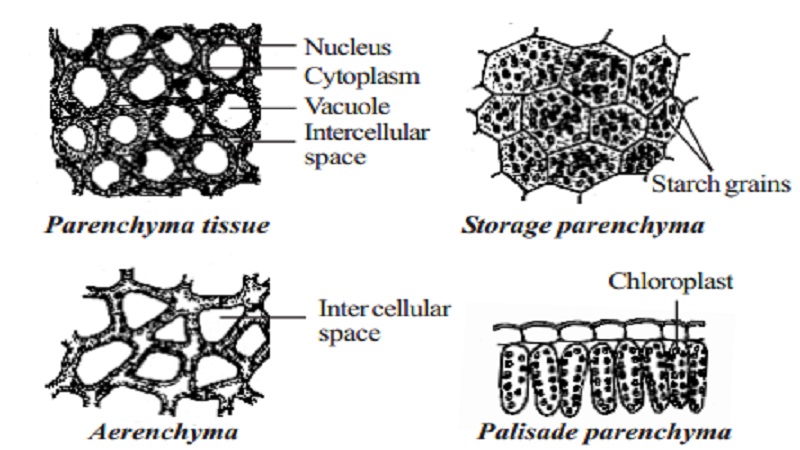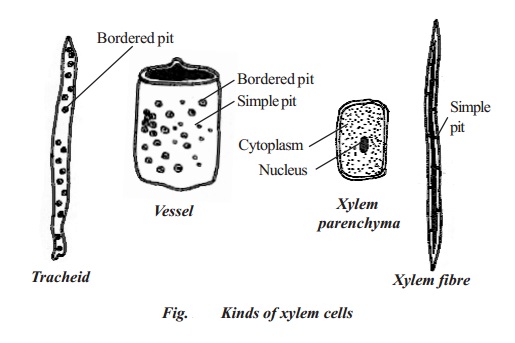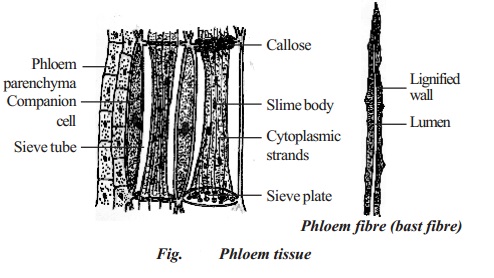Chapter: 11 th 12th std standard Bio Botany plant tree Biology Higher secondary school College Notes
Classification of permanent tissue : Simple and Complex tissue

Permanent tissue
The cells, which are formed by apical meristem, are differentiated into different types of permanent tissues. These tissues have lost the power of dividing either permanently or temporarily.
Classification of permanent tissue
Based on the constituent cells, the permanent tissue is classified into two types - simple tissue and complex tissue.
A.Simple tissue
A tissue with the cells of similar structure and function is called simple tissue. It is of three types - parenchyma, collenchyma and sclerenchyma.
1.Parenchyma
It is generally present in all organs of the plant. It constitutes the ground tissue in a plant. Parenchyma is the precursor of all the other tissues. Parenchyma is a living tissue and made up of thin walled cells. The cell wall is made up of cellulose. Parenchyma cells may be oval, spherical, rectangular, cylindrical or stellate. The cells are usually polyhedral with 10 to12 facets. Parenchyma is of different types and some of them are discussed as follows.
In water plants, the parenchyma found in the cortex region possesses well-developed large intercellular spaces called air spaces. This air filled parenchyma tissue is called aerenchyma. It helps the plant to float in water. eg. Nymphaea and Hydrilla. The parenchyma cells that are stored with starch grains are called storage parenchyma. eg. stem and root tubers. In the petioles of banana and Canna, star shaped parenchyma cells are found. These cells are called stellate parenchyma. In green parts of the plants, the parenchymatous cells have chloroplasts. These cells are called chlorenchyma. Its important function is photosynthesis.

2.Collenchyma
Collenchyma generally occurs in the dicot stems in two or more layers below the epidermis. These layers constitute the hypodermis. It is absent in the roots of land plants. It also occurs in petiole and pedicel. It gives strength to young organs. Collenchyma is a living tissue. It consists of more or less elongated cells, which are polygonal in cross section. The cell wall is unevenly thickened. The thickening is confined to the corners of the cells. Besides cellulose, the cell wall contains high amounts of hemicellulose and pectin.
Collenchyma may contain chloroplasts and carry out photosynthesis. Collenchyma is divided into three types - lamellar, angular and lacunate collenchyma.
In the hypodermis of Helianthus, only the tangential walls of collenchyma are thickened and the radial walls are devoid of thickening. This type of collenchyma is called lamellar collenchyma. In the hypodermis of Datura and Nicotiana, the cell walls of collenchyma are thickened at their angles. This type is called angular collenchyma. In the hypodermis of Ipomoea, the cell wall thickening materials are deposited on the walls bordering the intercellular spaces. This type is called lacunate collenchyma.

2.Sclerenchyma
Sclerenchyma is a dead tissue. The cells have lignified secondary walls. They lack protoplasts. On the basis of origin, structure and function, sclerenchyma is divided into two types - sclereids and fibres. The sclereids are different from fibres in the following respects. Sclereids are shorter whereas fibres are longer. Sclereids possess numerous pits as compared to the fibres.
B.Complex tissue
A tissue that consists of several kinds of cells but all of them function together as a single unit is called complex tissue. It is of two types x xylem and phloem.
1.Xylem
Xylem (Greek word 'xylos'= wood) is a complex tissue that is mainly responsible for the conduction of water and mineral salts from roots to other parts of the plant. The xylem, which is derived from procambium, is called primary xylem and the xylem, which is derived from vascular cambium, is called secondary xylem. Earlier formed xylem elements are called protoxylem, whereas the later formed xylem elements are called metaxylem. Xylem is made up of four kinds of cells - tracheids, vessels or tracheae, xylem fibres and xylem parenchyma.

2.Phloem
Like xylem, phloem is also a complex tissue. It conducts food materials to various parts of the plant. The phloem elements which are formed from the procambium of apical meristem are called primary phloem. The phloem elements which are produced by the vascular cambium are called secondary phloem. The primary phloem elements that develop first from the procambium are smaller in size called the protophloem, whereas those develop later are larger in size called metaphloem. The protophloem is short lived. It is crushed by the developing metaphloem.
Phloem is composed of four kinds of cells: sieve elements, companion cells,phloem parenchyma and phloem fibres. Companion cells are present only in angiosperms. Companion cells are absent in pteridophytes and gymnosperms. Phloem fibres are absent in the primary phloem of most of the angiosperms. But they are usually present in the secondary phloem.

Related Topics